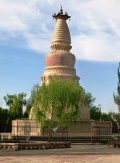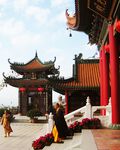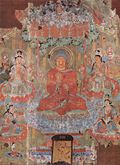Chinesischer Buddhismus: Unterschied zwischen den Versionen
Adm1 (Diskussion | Beiträge) |
Adm1 (Diskussion | Beiträge) |
||
| Zeile 24: | Zeile 24: | ||
* [//books.google.de/books?id=ecaRAgAAQBAJ&pg=PT116&lpg=PT116&dq=mahabheriharaka A Dictionary of Chinese Buddhist Terms]: With Sanskrit and English, Lewis Hodous,William E. Soothill , Englisch, Taylor and Francis, ISBN-10: 1135791236 ISBN-13: 9781135791230 (first published in 1937) | * [//books.google.de/books?id=ecaRAgAAQBAJ&pg=PT116&lpg=PT116&dq=mahabheriharaka A Dictionary of Chinese Buddhist Terms]: With Sanskrit and English, Lewis Hodous,William E. Soothill , Englisch, Taylor and Francis, ISBN-10: 1135791236 ISBN-13: 9781135791230 (first published in 1937) | ||
* [//books.google.de/books?id=Xg-gcQq1TGQC&pg=PA237&lpg=PA237&dq=Yuandun++Jiao(+teaching+of+Complete++and+sudden Popular Religious Movements and Heterodox Sects in Chinese History], Hubert Michael Seiwert | * [//books.google.de/books?id=Xg-gcQq1TGQC&pg=PA237&lpg=PA237&dq=Yuandun++Jiao(+teaching+of+Complete++and+sudden Popular Religious Movements and Heterodox Sects in Chinese History], Hubert Michael Seiwert | ||
* [https://books.google.de/books?id=PRoAyvEv3_IC&pg=PA351&lpg=PA351&dq=mahamaya+sutra Surviving Nirvana: Death of the Buddha in Chinese Visual Culture], Sonya S. Lee, Hong Kong Univ Pr, 2010, Englisch, ISBN-10: 9622091253 ISBN-13: 978-9622091252 | |||
== Referenzen == | == Referenzen == | ||
Version vom 16. September 2016, 12:50 Uhr
Der cinesische Buddhismus(Hànchuán Fójiào) setzte sich in China erst mit Beginn der Tang-Dynastie im siebten Jahrhundert durch. Der Baima - Tempel des Weißen Pferdes ist wahrscheinlich der erste buddhistische Tempel in China. Das Vajrayana gelangte auch über Dunhuang[1] nach China. Verbreitete Schulen sind
- Tiantai ( Lotos-Sutra[2][3], in Japan als Tendai - Schule)
- Huayan zong - Schule (Hua Yen) des Avatamsaka-Sutra
- Chan Meditationsbuddhismus ( Bodhidharma um 523 n.Chr.): Schwerpunkt auf unmittelbarer Erfahrung der Dinge, so wie sie sind ; daneben die Philosophie
- Schulen des Reinen Landes (chinesisch Jìngtǔ zōng, W.-G. Ching-t'u tsung) mit Buddhas und Bodhisattvas wie Amituofo (Amitabha) in sog. reinen Ländern wie Sukavati
- Mizong - Vajrayana
und als Ableger des Yogacara :
- Dilun - Schule
- Shelun - um eine Übersetzung des Mahayanasamgraha durch Paramartha
- Faxiang zong(Weishi, Vijñaptimātra: nur Bewusstsein) - Schule nach den Lehren des Vijnanavada [4]. Die Schule erlosch im neunten Jahrhundert.
Literatur
- Lu K'uan Yü: Geheimnisse der chinesischen Meditation : Bewusstseinskontrolle nach den Lehren des Ch'an, des Mahayana und der taoistischen Schulen in China , übersetzt von Hans-Ulrich Rieker, Bauer-Verlag, 1984, ISBN: 3762606137 (EAN: 9783762606130 / 978-3762606130)
- Das Lotussutra als PDF
- Das Avatamsaka Sutra (The Flower Garland Sutra) als PDF
- Teachings on chinese buddhism
- Pure land buddhism
- Buddhism in China
- Teachings in Chinese Buddhism — The Most Venerable Yin Shun.
- Popular deities in chinese buddhism
- A Dictionary of Chinese Buddhist Terms: With Sanskrit and English, Lewis Hodous,William E. Soothill , Englisch, Taylor and Francis, ISBN-10: 1135791236 ISBN-13: 9781135791230 (first published in 1937)
- Popular Religious Movements and Heterodox Sects in Chinese History, Hubert Michael Seiwert
- Surviving Nirvana: Death of the Buddha in Chinese Visual Culture, Sonya S. Lee, Hong Kong Univ Pr, 2010, Englisch, ISBN-10: 9622091253 ISBN-13: 978-9622091252
Referenzen
Weblinks
- en Wiki zum Buddhismus in China
- Sutras und Texte
- The Chinese Buddhist Schools
- Buddhist scools
- Korean Seon Hwadu Meditation
- Buddhism in China
<historylink type="back" style="font-family: Arial, Helvetica, sans-serif;
font-size: 14px; color: #ffffff; padding: 4px 8px; float:right;
background: -moz-linear-gradient( top, #fcf9fc 0%, #6a75eb);
background: -webkit-gradient( linear, left top, left bottom,
from(#fcf9fc), to(#6a75eb));
-moz-border-radius: 30px; -webkit-border-radius: 30px;
border-radius: 30px; border: 3px solid #ffffff;
-moz-box-shadow: 0px 3px 11px rgba(240,237,240,0.5),
inset 0px 0px 1px rgba(000,145,255,1);
-webkit-box-shadow: 0px 3px 11px rgba(240,237,240,0.5),
inset 0px 0px 1px rgba(000,145,255,1);
box-shadow: 0px 3px 11px rgba(240,237,240,0.5),
inset 0px 0px 1px rgba(000,145,255,1);
text-shadow: 0px -1px 0px rgba(000,000,000,0.2),
0px 1px 0px rgba(255,255,255,0.3);"
> zurück </historylink>


